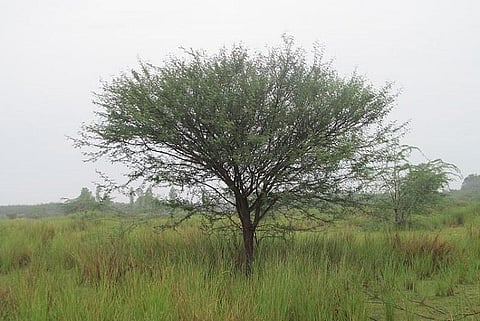

Over a year after the Madurai bench of the Madras High Court ordered the state government to completely eradicate the Seemai Karuvelam tree from Tamil Nadu, the first bench of the HC has hit the pause button on the task.
The Karuvelam tree, or prosopis juliflora as it’s known biologically, is a species native to West Africa and was brought to Tamil Nadu in 1960s as fuelwood. Slowly, these seeds started drifting into dams and rivers, causing problems. The plant according to multiple reports, absorbs excess ground water, adding to the woes of the water-starved state. Following multiple petitions and media reports, the Madurai bench banned its plantation and then demanded that the entire species be removed from the state.
Initially, the bench directed Collectors and other Revenue department officials of 13 districts under the territorial jurisdiction of the Madurai Bench to uproot Seemai Karuvelam trees from public as well as private lands. However, disappointed by the slow pace of progress, the bench then ordered the respective principal judges and district munsifs to inspect the work carried out by officials. A contingent of 65 advocate commissioners were even appointed to supervise the eradication of trees.
(Image: "A scene of Prosopis juliflora" by Thamizhpparithi Maari - Own work. Licensed under CC BY-SA 3.0 via Commons - https://commons.wikimedia.org/wiki)
If this weren't enough, on February 10, the order to uproot trees extended to all districts across the state and High Court judges decided to supervise the task themselves. In districts such as Madurai, Sivaganga and Pudukkottai judges ventured out to watch first-hand how their directives were being implemented.
After this 'judicial activism', what caused the court to now stop this felling of trees?
The first Bench of Chief Justice Indira Banerjee and Justice M Sundar gave this ruling after a public interest litigation (PIL) was filed by an advocate on Friday.
The petitioner claimed that the perception that Karuvelam trees consumed a lot of water was a misconception. He further questioned how they could be eliminated based on 'mere fears'. The petitioner prayed for a directive to the state government to form a panel of experts to decide the alleged ill-effects of the plant and submit a report. His interim prayer was to restrain the authorities from drastically removing them.
Environmentalists divided on decision
"I have never seen authorities upholding any other law with the vigour they display when it comes to uprooting trees," observes Nityanand Jayaraman, an environmentalist. "Somehow it seems like it is the contractor lobby, timber and the like, that will benefit out of this silly move. We have to understand that certain ecological systems depend on this tree now and it simply cannot be eradicated, " he adds.
Nityanand is referring to the IIT Madras campus which recently saw the forest department intervene to stop the uprooting of Seemai Karuvelam trees. Authorities at the institute in Chennai ordered for the removal of the trees from the campus, based on directives from the district administration. The trees reportedly provided shade to blackbucks that resided within the campus.
Jayashree Venkatesan, a managing trustee of Care Earth trust, however disagrees with this viewpoint. Despite having seen local economies that depend on the tree for a living in Pudukkottai and Ramanathapuram, she says it must be removed. "This is like the case of goose that laid the golden egg. For temporary benefit, you cannot kill the goose. The government can find an alternative for those who depend on the tree," she says. Jayashree emphasises on the tree's natural tendency to aggravate water stress in areas it is allowed to grow unchecked. "It is fundamental biology that a plant that proliferates in this rapid manner will suck the nutrients and water from the soil. Wetlands have completely disappeared in areas where these trees thrive and if they are not removed the situation will only deteriorate," she adds.
She however agrees that that the manner of removal must be well thought out. "These trees have low mortality rates and their seeds remain robust for a long time after they leave the tree. The removal should not trigger more invasive species," says Jayashree. The method, equipment and time frame for removal, she says, have to be planned in a scientific manner.
"There is no such thing as invasive species in nature," argues Nityanand. "What we have to do is figure out how to live with it. Yes, in areas meant for agriculture and the like cannot afford to have these plants and they should be removed. But we cannot ruin the ecological balance. In one of the worst drought the state is facing, you cannot remove the little ground cover it has. It is a stupid thing to do," he concludes.